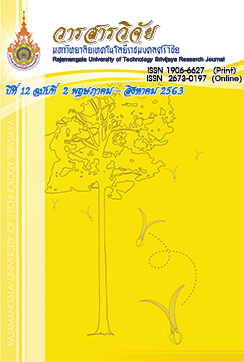Types of Dough Sheet and Filling for Spring Roll Production
Keywords:
wonton dough sheet, roti dough sheet, spring roll, green curryAbstract
The objective of this research was to study two types of dough sheets: wonton and roti dough sheets. Different types of stuff for making spring roll were used: minced pork mixed with vermicelli noodle, minced pork mixed with mackerel kua kling, minced pork mixed with mackerel green curry, and spicy minced pork mixed with mackerel. The results showed that the spring roll with wonton dough sheets maintained the crispness well after frying while the minced pork mixed with mackerel green curry stuff obtained the highest overall acceptability score. The optimum bite-size piece of spring roll was made from 4.5 × 7 cm2 wonton dough sheets with 3-gram minced pork mixed with mackerel green curry stuff. The consumer acceptance test indicated that the features of color, size, shape, quality of stuff, overall taste, crispness and overall liking were highly found at 7.55 7.71 7.65 7.57 7.58 7.72 and 7.65, respectively. The moderate fondness on curry odor, salt and spicy was perceived at 7.44 7.26 and 7.34, respectively. The fried spring roll with minced pork mixed with mackerel green curry stuff had L*, a* and b* values of 55.86, 6.52 and 40.70, respectively; protein 15.85%, fat 8.71%, energy 291 kilocalories/100 grams, hardness 1.34 N, chewiness 1.12 N.mm. and fracturability 0.27 N.
References
จันทร์เพ็ญ มะลิพันธ์ และ ปิยธิดา สุดเสนาะ. 2553. ผลของแคปป้าคาราจีแนนร่วมกับกรดแอสคอร์บิกต่อคุณภาพโรตีแช่เยือกแข็ง. วารสารวิทยาศาสตร์เกษตร 41(3/1)(พิเศษ): 441-444.
ธารดาว ทองแก้ว. 2546. น้ำมันพืช : ใช้อย่างไรให้ถูกต้องและปลอดภัย. นิตยสารหมอชาวบ้าน 25(291): 17-24.
ธงชัย สุวรรณสิชณน์. 2535. การพัฒนาอาหารขบเคี้ยวจากแป้งถั่วลิสงไขมันต่ำผสมแป้งมันสำปะหลังชนิดพรีเจลาติไนซ์. วิทยานิพนธ์ปริญญาวิทยาศาสตรมหาบัณฑิต, มหาวิทยาลัยเกษตรศาสตร์.
เบญจมาภรณ์ ภัทรนาวิก, ดวงฤทัย ธำรงโชติ และ รุ่งทิวา วงค์ไพศาลฤทธิ์. 2550. รายงานการวิจัย การพัฒนาผลิตภัณฑ์ปอเปี๊ยะแช่เยือกแข็งแบบช้า. คณะเทคโนโลยีคหกรรมศาสตร์, มหาวิทยาลัยเทคโนโลยีราชมงคลกรุงเทพฯ.
พรรณี วงศ์ไกรศรีทอง. 2530. การผลิตข้าวเกรียบปลาโดยใช้เครื่องรีดแผ่น. วิทยานิพนธ์ปริญญาคหกรรมศาสตรมหาบัณฑิต, มหาวิทยาลัยเกษตรศาสตร์.
รสิตา โอสถานนท์. 2547. เทคโนโลยีของธัญญาหาร. พิมพ์ครั้งที่ 2. สำนักพิมพ์มหาวิทยาลัยรามคำแหง, กรุงเทพฯ.
สถาบันอาหาร. 2552. แนวโน้มอุตสาหกรรมอาหารพร้อมปรุง-พร้อมทานในตลาดโลกกับอนาคตที่สดใส. อุตสาหกรรมสาร 52: 5-7.
อุบล ดีสวัสดิ์. 2547. อาหารจีนยอดนิยม. บริษัทสำนักพิมพ์แม่บ้าน, กรุงเทพฯ.
Blumenthal, M.M. 1991. A new look at the chemistry and physical of deep gat frying. Food Technology 45(2): 68-71.
Tester, R.F. and Morrison, W.R. 1990. Swelling and gelatinization of cereal starches. II. Waxy rice starches. Cereal Chemistry 67: 558-563.
Downloads
Published
How to Cite
Issue
Section
License
The content and information in the article published in Journal of Rajamangala University of Technology Srivijaya It is the opinion and responsibility of the author of the article. The editorial journals do not need to agree. Or share any responsibility.







